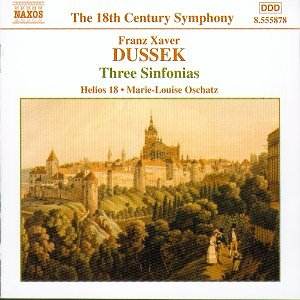F.X. Dussek seems to be almost new to the CD catalogues.
I say "almost" because Naxos do not declare these to be premiere
recordings. Yet, search though one might, no more seems to be in the
public domain. Dussek was a Bohemian composer active in the second half
of the 18th century in Prague. He is not to be confused with
Jan Ladislav Dussek a slightly later composer famed for his piano music.
The Concise Grove is careful to avoid confusion by spelling the present
one Dušek. The excellent notes by Dr Allan Badley, a New Zealand musicologist,
must be as close to definitive as possible since he is responsible for
the preparation for publication of these and a few other symphonies
by Dussek. So far as I can tell his is the only expert voice. He is
a driving force behind Naxos’s excellent series, of which this is part
- The 18th Century Symphony. Dussek must be compared
with Vanhal, Wagenseil, Hofmann and indeed no less a figure than Mozart,
whom he knew quite well. The three symphonies recorded here are uniformly
enjoyable and include their fair share of delightfully weird effects,
to show us that Haydn was not the only humourist of the 18th
century symphony. The first movement of the E flat Sinfonia is typical
of the inventiveness and variety with which our ears are charmed throughout.
But I am not totally won over by this disc, despite
its rarity value, because the period orchestra Helios 18, just
that number of young musicians, seems dogged by odd intonation. At times,
listening to this disc was like hearing a slightly off-centre LP. Indeed,
were it not for the clear statement of recording date (see above) I
might have wondered if a rogue analogue tape had emerged from Dr Badley’s
researches in the archives. Generally the orchestra plays with enthusiasm
and enough virtuosity to make listening a pleasure. There are passages,
the finale of the last Sinfonia in F major for example, where the rhythmic
complexity of the music is handled with real aplomb.
The recording has its weaknesses, the bass tends to
boom, and the sound has not got much space around it. But, praise be,
the harpsichord is properly balanced within the texture and is thus
just audible, as it should be.
The biographical note on the orchestra and its director
Marie-Louise Oschatz, plus the CD cover blurb, were clearly not written
by the skilled and erudite Dr Badley, for, factual matter apart, they
are full of non sequiturs and plain nonsense. At one point it seems
to be suggested that the orchestra is not attempting to reconstruct
authentic performances but playing on authentic instruments because
the music sounds right that way. Er, what’s the difference?
Dave Billinge


